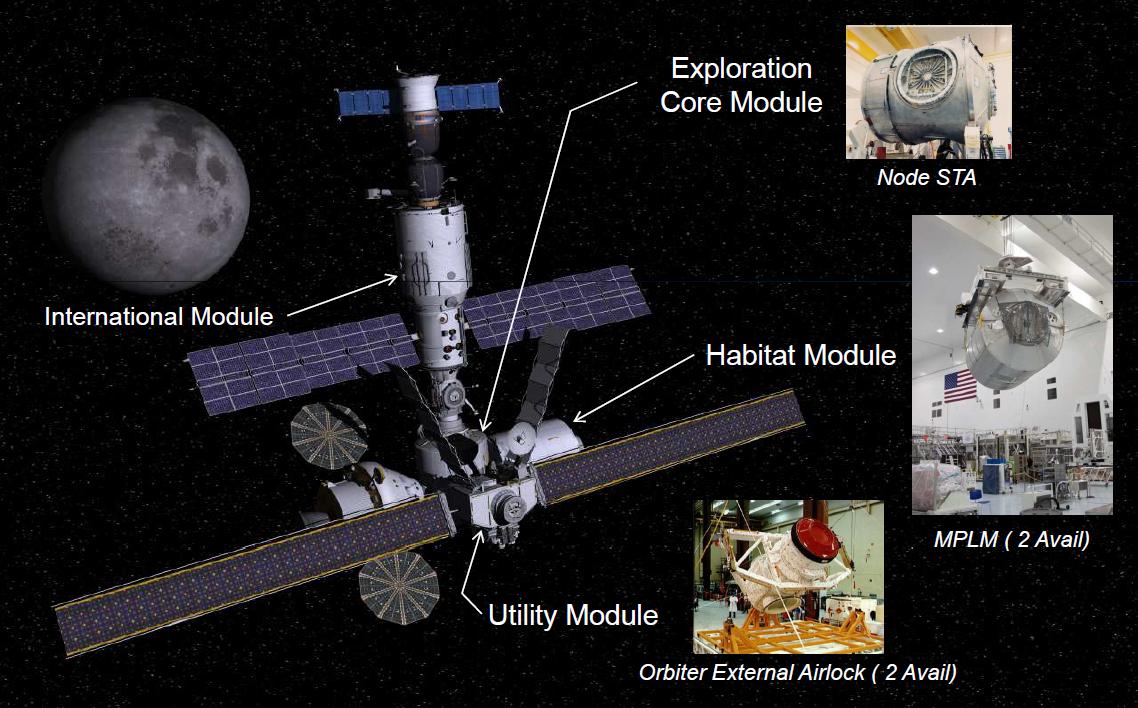Exploration Gateway Platform on:
[Wikipedia]
[Google]
[Amazon]
 The Exploration Gateway Platform was a design concept proposed by
The Exploration Gateway Platform was a design concept proposed by
 The Exploration Gateway Platform was a design concept proposed by
The Exploration Gateway Platform was a design concept proposed by Boeing
The Boeing Company, or simply Boeing (), is an American multinational corporation that designs, manufactures, and sells airplanes, rotorcraft, rockets, satellites, and missiles worldwide. The company also provides leasing and product support s ...
in December 2011 to drastically reduce the cost of Moon
The Moon is Earth's only natural satellite. It Orbit of the Moon, orbits around Earth at Lunar distance, an average distance of (; about 30 times Earth diameter, Earth's diameter). The Moon rotation, rotates, with a rotation period (lunar ...
, near Earth asteroids
A near-Earth object (NEO) is any small Solar System body orbiting the Sun whose closest approach to the Sun (Apsis, perihelion) is less than 1.3 times the Earth–Sun distance (astronomical unit, AU). This definition applies to the object's orb ...
(NEAs), or Mars
Mars is the fourth planet from the Sun. It is also known as the "Red Planet", because of its orange-red appearance. Mars is a desert-like rocky planet with a tenuous carbon dioxide () atmosphere. At the average surface level the atmosph ...
missions by using components already designed to construct a refueling depot and servicing station located at one of the Earth–Moon Lagrange point
In celestial mechanics, the Lagrange points (; also Lagrangian points or libration points) are points of equilibrium for small-mass objects under the gravitational influence of two massive orbiting bodies. Mathematically, this involves t ...
s, L1 or L2. The system claims its cost savings based on an ability to be reused for multiple missions such as a launch platform for deep space exploration, robotic relay station for moon rovers, telescope servicing and a deep space practice platform located outside the Earth's protective radiation belts.
The platform would be constructed at the International Space Station
The International Space Station (ISS) is a large space station that was Assembly of the International Space Station, assembled and is maintained in low Earth orbit by a collaboration of five space agencies and their contractors: NASA (United ...
(ISS) for testing before being relocated to EM-L1 or EM-L2 via electric or chemical propulsion rockets.
Construction
The Platform would consist of parts left over from the ISS program. Parts under consideration were Node 4 to form the main connection point, parts from theSpace Shuttle
The Space Shuttle is a retired, partially reusable launch system, reusable low Earth orbital spacecraft system operated from 1981 to 2011 by the U.S. National Aeronautics and Space Administration (NASA) as part of the Space Shuttle program. ...
's Orbital Maneuvering System (OMS) and Orbiter External Airlock would be combined to form a utility module for maneuvering, orientation and Extra-vehicular activity
Extravehicular activity (EVA) is any activity done by an astronaut in outer space outside a spacecraft. In the absence of a breathable Earthlike atmosphere, the astronaut is completely reliant on a space suit for environmental support. EVA i ...
(EVA), a smaller version of the Canadian Arm to help with logistic and station-keeping, TransHab and/or possible inclusion of a ' Zvezda 2' or a Bigelow Inflatable station for life support systems, crew accommodations, storage, and laboratory space. Most components would be lifted into orbit using currently available EELV or commercial launchers.
A reusable lander would be positioned at the platform for Moon landings and refueled using NASA
The National Aeronautics and Space Administration (NASA ) is an independent agencies of the United States government, independent agency of the federal government of the United States, US federal government responsible for the United States ...
's new SLS
SLS may refer to the Space Launch System, a launch vehicle developed by NASA. It may also refer to:
Education
* Stanford Law School, California, U.S.
* Sydney Law School, Australia
* Symbiosis Law School, India
* Same language subtitling, of ...
heavy lift vehicle.
See also
*Lunar Gateway
The Lunar Gateway, or simply Gateway, is a planned space station which is to be assembled in orbit around the Moon. The Gateway is intended to serve as a communication hub, science laboratory, and habitation module for astronauts as part ...
* Deep Space Habitat
The Deep Space Habitat (DSH) is a series of concepts explored between 2012 and 2018 by NASA for methods to support crewed exploration missions to the Moon, asteroids, and eventually Mars.Chris GebhardtDeep Space Habitat module concepts outlined fo ...
* Lunar Orbital Station
The Lunar Orbital Station (; LOS) is a proposed Russian space station which would orbit around the Moon. The design was presented in 2007 at a conference at the Gagarin Cosmonaut Training Center in Star City, Russia, Star City. It is one of the tw ...
* Nautilus-X
* Skylab II
* Space station
A space station (or orbital station) is a spacecraft which remains orbital spaceflight, in orbit and human spaceflight, hosts humans for extended periods of time. It therefore is an artificial satellite featuring space habitat (facility), habitat ...
References
{{Space stations Proposed space stations